This article was published in Scientific American’s former blog network and reflects the views of the author, not necessarily those of Scientific American
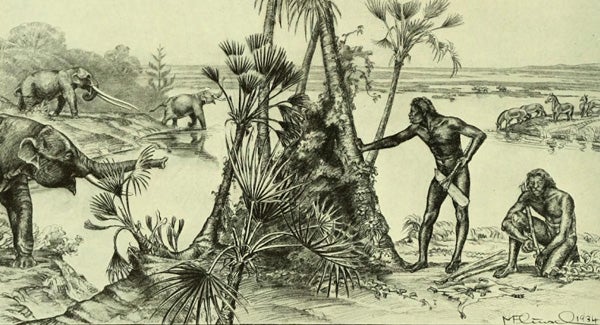
One of my favourite reconstructions of Piltdown man. It's by Margaret Flinsch and shows supposedly associated proboscideans and horses in a surprisingly tropical Plio-Pleistocene England. Note the (in)famous tool being held by the hominin on the left.
One of the most fascinating episodes in the history of palaeontology is that of Piltdown man, an alleged human ancestor discovered in 1908 at Piltdown in Sussex, England. Formally named Eoanthropus dawsoni in 1912, Piltdown man matched early 20th century expectations of what a human ancestor might be like. It combined a large brain with an ape-like jaw (therefore confirming ideas that the evolution of big brains led the way in hominin evolution), and it lived in Europe (confirming ideas that hominin evolution was a Eurasian event, the hominins of Africa and tropical Asia being divergent irrelevancies or side-branches). The African australopithecines had yet to be discovered, nor had scarcely any of the wealth of fossil African hominins we know of today.
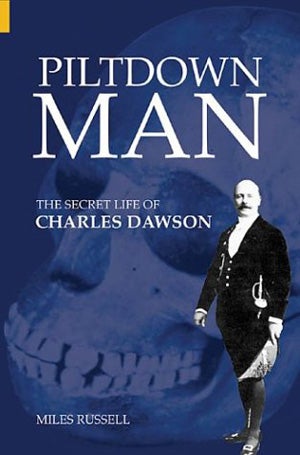
The case against Dawson is really strong. I thought this ever since learning of the Booth Museum 'toad in the hole' when I was about 12. Anyway, the full case was put together by Russell in 2003.
On supporting science journalism
If you're enjoying this article, consider supporting our award-winning journalism by subscribing. By purchasing a subscription you are helping to ensure the future of impactful stories about the discoveries and ideas shaping our world today.
The one thing that every single person who’s heard of Piltdown man knows is that it was eventually determined to be a hoax. This didn’t happen until 1953 when Kenneth P. Oakley, Wilfrid E. Le Gros Clark and Joseph Weiner showed how an orangutan jaw and human skull fragments had all been combined to fool the scientists of the day (Weiner et al. 1953). Exactly who the perpetrator was and what their motives were remain debated, and an enormous amount of work has been published on this subject. This article is not about that particular part of the story, though I will say that amateur archaeologist and palaeontologist Charles Dawson was (in my view) the person most likely to have been behind the hoax.
What’s discussed rather less frequently is that early 20th century views on Piltdown man were far more complex than popularly portrayed. Acceptance of Eoanthropus as a valid proto-human might have been the ‘mainstream’ view that made it into textbooks and encyclopedias, but it certainly wasn’t the only one, nor was this acceptance wholesale or uncontroversial.
Also not especially well known is that Piltdown man was not a singleton. Two specimens were found at locations about 3 km apart. These are known as Piltdown I and Piltdown II, though the Piltdown II specimen (sometimes called the Sheffield Park specimen, and consisting of skull fragments and a tooth) was never properly described, nor was the site identified with precision.
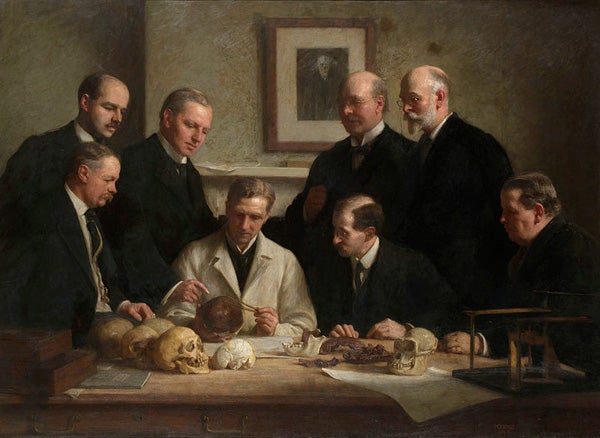
John Cooke's famous 1915 'Piltdown gang' painting. Arthur Keith sits in the middle. Standing at the back (left to right): Barlow, Elliot Smith, Dawson, Woodward. Sitting on the left: Underwood. Sitting at right (left to right): Lankester, Pycraft. This is a big, imposing piece of work - see the photo below. Image in the public domain.
Piltdown man’s describer was Arthur Smith Woodward of the (then) British Museum (Natural History). But Woodward was an ichthyologist and many have wondered if he did himself a favour in devoting so much time and energy to an area that was not his speciality. Regardless, these concerns over Woodward’s expertise did not affect acceptance of Eoanthropus as an ancestor to modern humans among British palaeontologists. Several of Woodward’s colleagues – most notably zoologist William Pycraft (best known for his ornithological work) – were vocal and aggressive supporters of Woodward’s interpretation.
Dualism and the dualists
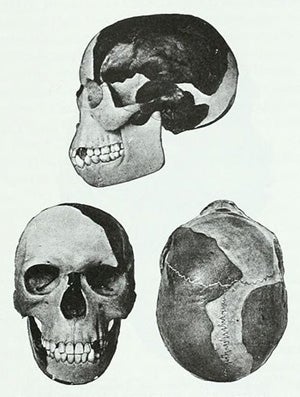
James McGregor's Eoanthropus skull reconstruction of 1921. Image in public domain.
Long prior to 1953 however, certain other anthropologists, primatologists and mammalogists were of the opinion that the cranium and jaw of Piltdown I did not go together, and that while the cranium was human, the jaw was from a chimpanzee or some other non-human ape. In fact, some workers voiced doubts about the authenticity of Woodward’s reconstruction within just two or three years of 1912. We might even go as far as saying that quite a few anthropologists and mammalogists of the early 1900s would not have been surprised on learning that it was a hoax, and some might even have suspected that this is exactly what it was.
This idea that the material was of a ‘dual’ nature became known as dualism, its supporters the dualists. Martin Hinton, a zoologist at the British Museum (Natural History) often linked with the hoax (Gardiner 2003), claimed that he had been aware of this duality since 1912 at least, and he noted that Oldfield Thomas, the museum’s leading mammalogist, was of the same opinion. Of course Hinton’s apparent brilliance takes on a different light if he was the hoaxer as some claim, and he did not come forward with this view until the 1950s.
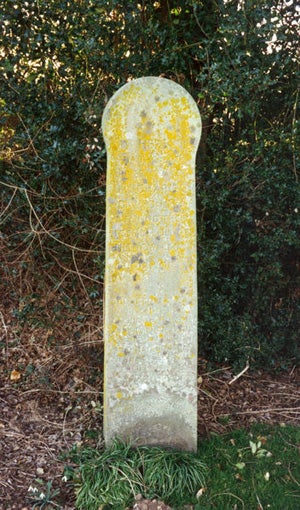
There's a Piltdown man memorial - I really must go and see it some time. There's a Piltdown man pub too. We should arrange a fieldtrip. Image by Nick Woolley, CC BY-SA 2.5.
In 1913, King’s College anatomist David Waterston argued that the Piltdown I jaw was emphatically not that of a human, and that associating it with a human-like cranium was as incongruous as articulating a chimpanzee foot with a human leg (Waterston 1913).
This view was also championed by Gerrit Smith Miller – assistant curator of mammals at the United Stated National Museum in Washington – in 1915 (Miller 1915), and by both French palaeontologist Marcellin Boule and German anthropologist Franz Weidenreich in 1923 (Spencer 1990, Walsh 1996, MacRitchie 2011).
Miller’s views and comments were especially well argued, useful and significant. He showed how chimpanzee jaws could, if broken in exactly the right places, end up looking almost identical to the jaw of Piltdown I, and he also argued that various details of the cranium indicated that it and the jaw simply could not have belonged to the same one animal (Miller 1915). He revisited the topic of Piltdown man on a few later occasions (Miller 1918, 1920).
Miller (1915) concluded that the jaw represented a European chimp which he dubbed Pan vetus. The cranium, he thought, should be referred to the genus Homo and the name Eoanthropus, he proposed, should be discarded. Because the jaw and cranium were missing those parts that would ordinarily reveal the way in which they articulated, Miller (1915) noted that “Deliberate malice would hardly have been more successful than the hazards of deposition in so breaking the fossils as to give free scope to individual judgement in fitting the parts together”.
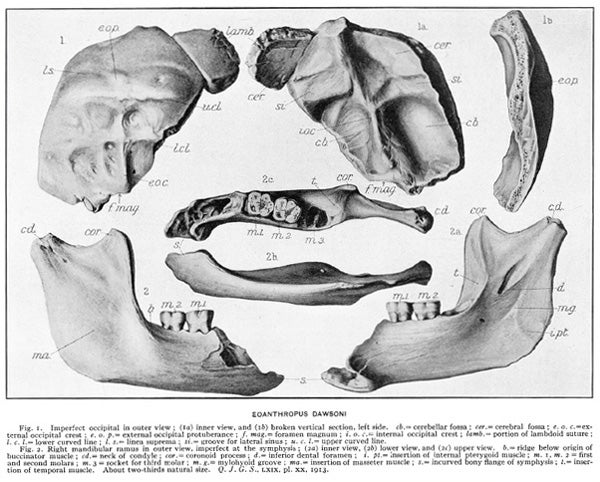
The Piltdown man partial cranium (shown in three views at the top) and mandible (shown in four views at the bottom).
It has been claimed that Miller suspected fraud right from the start (T. D. McCown, in Oakley & Groves 1970) but that he was persuaded to tread lightly given the seriousness of the accusations. We also know that, in 1930, Miller asked Remington Kellogg (best known for his work on fossil whales) to look at the Piltdown I jaw in order to see if the teeth had been artificially modified (Oakley & Groves 1970).
Some of Miller’s colleagues agreed with him, including the American Museum of Natural History’s William King Gregory (1876-1970). But the reaction from others was extremely negative, most notably Pycraft. Furthermore, such noted American workers as Henry Fairfield Osborn and William Diller Matthew accepted Woodward’s interpretation, not Miller’s. Indeed Osborn became a prominent Piltdown proponent after viewing the material in 1921 (Osborn even visited Barkham Manor – the discovery site – with Woodward). Perhaps because of this weight of consensus, Gregory eventually changed his mind as goes agreeing with Miller, and did so at about the same time that Osborn and Matthew were voicing their support for Woodward’s interpretation.
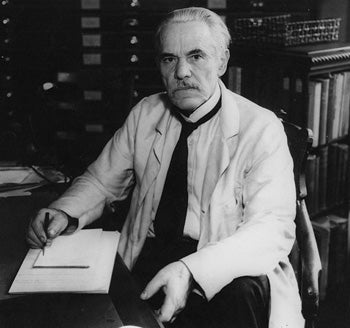
Aleš Hrdlička, photographed in 1930. Image in public domain.
At least one researcher remained on Miller’s side however. Aleš Hrdlička (1869-1943), curator of physical anthropology at the National Museum of Natural History (Washington D.C.), also opposed Woodward’s reconstruction, and also became a dualist. In articles published in 1923 and 1924 he argued that the braincase was essentially that of a modern human while the jaw was from some sort of chimp-like ape, perhaps a dryopithecine (Hrdlička 1923, 1924). Given the poor stratigraphic data recorded from the Piltdown excavation, Hrdlička even intimated that the cranium might be a modern burial that had been incorporated into older strata. We know that Hrdlička and Miller corresponded extensively on Piltdown and it’s possible that Hrdlička instigated Miller’s further research into the subject. As an aside, in his 1990 book on the Piltdown saga, Frank Spencer drew attention to Hrdlička’s efforts of 1912 and before to critically assess Florentino Ameghino’s (1854-1911) startling claims of South American ancestry for humans (Hrdlička and colleagues published a book on this subject in 1912), noting that “Hrdlička was distressed to find his Anglo-Saxon colleagues headed in the same direction” (Spencer 1990).
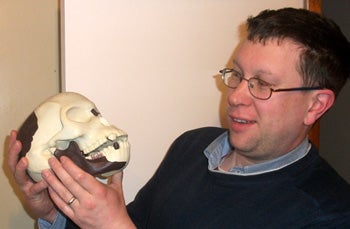
It's not the original, but it's good enough.
Hrdlička spent time with the Piltdown fossils in 1922. He was troubled by how impossibly similar the molars of Piltdown I and Piltdown II were to one another in every detail, and he wondered if the Piltdown II tooth might have been mislabelled: could it actually be part of the Piltdown I remains? With the benefit of hindsight we can say now that this was another obvious clue indicating the fraudulent nature of the remains. Of course Hrdlička was not about to make such a bold claim.
Why were the dualists ignored?
The dualist arguments were there right throughout the sorry history of one of palaeontology’s greatest and most notorious hoaxes, yet were ignored or waved away by several prominent workers who held influential positions. Piltdown’s proponents (like Pycraft) used the weight of authority and special access to the material to dismiss or quash the dualist’s arguments. This is despite the fact that those who made the dualist arguments were actually more qualified, more experienced, and more ‘relevant’ (as goes their qualifications and areas of expertise) when compared to the proponents.
Dualism is discussed at length in all the good books on Piltdown and also formed the focus of one of Stephen Gould’s essays. I would say the same as Gould and other commentators: if leading workers in England, the USA and elsewhere had not been so invested, so committed, in the supposed authenticity of Piltdown man, if only they had listened to their detractors – to Miller, Hrdlička and others – they might well have accepted and understood the very reasonable, very well supported arguments of the dualists. Alarm bells were ringing right from the start.
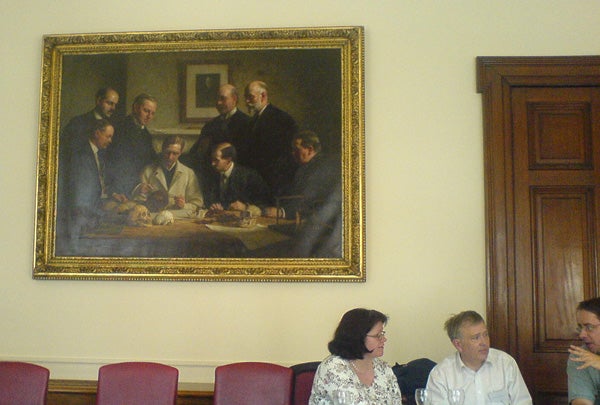
Here's that painting by John Cooke, in its home at Burlington House, the Geological Society of London. Humans for scale. Photo by Darren Naish.
Long-time readers might know that this article has been mentioned on and off since 2006. I finally decided to dust it off and get it finished. For previous Tet Zoo articles on hominins and other primates, see...
Marmosets and tamarins: dwarfed monkeys of the South American tropics
Nasalis among the odd-nosed colobines or The “Nasalis Paradox” (proboscis monkeys part II)
Refs - -
Gardiner, B. G. 2003. The Piltdown forgery: a re-statement of the case against Hinton. Zoological Journal of the Linnean Society 139, 315-335.
Hrdlička, A. 1923. Variation in the dimension of lower molars in man and anthropoid apes. American Journal of Physical Anthropology 6, 195-216.
- . 1924. New data on teeth of early man and certain other fossil European apes. American Journal of Physical Anthropology 7, 109-132.
MacRitchie, F. 2011. Scientific Research as a Career. CRC Press, Boca Raton, USA.
Miller, G. S. 1915. The jaw of Piltdown man. Smithsonian Miscellaneous Collections 65, 1-31.
- . 1918. The Piltdown jaw. American Journal of Physical Anthropology 1, 25-52.
- . 1920. The Piltdown problem. American Journal of Physical Anthropology 3, 585-586.
Oakley, K. P. & Groves, C. P. 1970. Piltdown man: the realization of fraudulence. Science 169, 789.
Spencer, F. 1990. Piltdown: A Scientific Forgery. British Museum (Natural History) & Oxford University Press.
Walsh, J. E. 1996. Unravelling Piltdown. Random House, New York.
Waterston, D. 1913. The Piltdown mandible. Nature 92, 319.
Weiner, J. S., Oakley, K. P. & Le Gros Clark, W. E. 1953. The solution of the Piltdown problem. Bulletin of The British Museum (Natural History) Geology 2, 141-146.